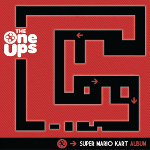Super Mario Kart Album
 |
Album Title: Super Mario Kart Album |
| Record Label: OneUp Studios |
|
| Catalog No.: OUS-008 |
|
| Release Date: May 4, 2010 |
|
| Purchase: Buy at Bandcamp |
Overview
One of the many elements that made Super Mario Kart so enjoyable was its music. Soyo Oka managed to create a score that had distinctive jazz elements and a driving sound, yet still sounded like Mario. While the original score was never released on an album, it has continued to be popular in the fan community and has even enjoyed attention from fan arrangers. The OneUps memorably commemorated the score’s “Koopa Beach” on their outstanding debut album and, in 2010, decided it was time for more. Available as both a digital and physical release, their Super Mario Kart Album features ten arrangements performances dedicated to the score. It’s a pretty short album, but is it still a good one?
Body
It’s clear from the opening tracks that The OneUps are once again comfortable with interpreting material from Super Mario Kart. Their interpretation of the title theme features pleasants interplay between guitarists Tim Yarbrough and William Reyes against a bossa-nova rhythm. Like many entries on the album, it’s dissatisfyingly brief and rather repetitive, yet it still seems so ‘right’ given the original game. “Mario Circuit” is the first fully-fledged arrangement on the album and captures the propulsive feel of the original with its funk rhythms. More melodic passages, such as from the 1:14 mark, are especially energetic and liberating. Several tracks also feature pleasant twists on the band’s typical laid-back jazz style. “Donut Plains” features a surprising flute lead — perhaps compensating for violinist Greg Kennedy’s disappointing absence from the album — while “Battle Mode” features more experimental synthesizer work and wah-wah sounds. Neither are particularly groundbreaking, but they at least add some diversity and novelty into an often barren album.
Unfortunately, most of the band’s other attempts at ‘experimentation’ fall flat. Expectedly, “Bowser Castle” injects a bit of hard rock into the album, yet it ends up sounding lame. The track initially makes a major impact with its overdriven guitar lines and off-beat drum line, but it becomes increasingly desperate with its development. The simple lead melody — if it can be called that — is laboured throughout the playtime and the new sections have an irreverent quality to them. The premature climax thankfully puts the track out of its misery, but with its absolutely ridiculous and unnecessary death metal growling, also confirms that this album will only ever be a ‘geek-only’ affair. Another one of the darker entries of the album, “Ghost Valley”, makes an interesting attempt to incorporate the ghostly dissonance of the original into an experimental funk performance. It creates a superficially interesting timbre with its spacey keyboard solos, warm synthpads, and jagged drum kit. However, it is a very straightforward piece when stripped down — with repetitive harmonies, derivative solos, and little development — so doesn’t really push the boundaries it could have done.
The Caribbean-themed “Choco Island” is one of the few saxophone-based tracks on the album. It’s a very straightforward one at that and the saxophone sounds somewhat overexposed playing the melody. “Vanilla Lake” is a little more elaborate — featuring pleasant interplay between tenor saxophonist and nylon guitarist — though verges dangerously towards imitating commercial smooth jazz. Anyone who has listened to The OneUps Volume 1 will know that Anthony Lofton is a talented saxophonist, so it’s a pity that his abilities aren’t tested with less stereotypical tracks. Does the intended magnum opus of the album, “Rainbow Road”, rescue it from mediocrity? Once again, listeners are faced with problems that plagued other entries in the album — inappropriate instruments to treat the melodies, jazz-by-numbers solos, and repetitive functional harmonies — but at least Mustin and co. are able to offer decent value for money this time. After all, this track is one of the few that develops comprehensively and it at least captures the exuberance and nostalgia of Soyo Oka’s original piece throughout.
Summary
Super Mario Kart Album is basically a geek-tailored album: its melodic focus is unyielding, its jazz stylings are superficial, and its novelty features are cheesy. It’s clear throughout the album that Mustin and co. didn’t really want to rock the boat here and instead just did the bare minimum to satisfy the restricted fanbase. However, they could have created a much more interesting album for wider audiences if they demonstrated more artistic jazz leanings, took time to comprehensively develop tracks and build interesting solos, and avoided embarrassing features like the growling in “Bowser Castle”. It’s clear that The OneUps have watered themselves down since their debut and, while their offerings on Super Mario Kart Album are generally accessible and likeable, they could have been much more ambitious and satisfying.
Do you agree with the review and score? Let us know in the comments below!
3
Posted on August 1, 2012 by Chris Greening. Last modified on August 1, 2012.














